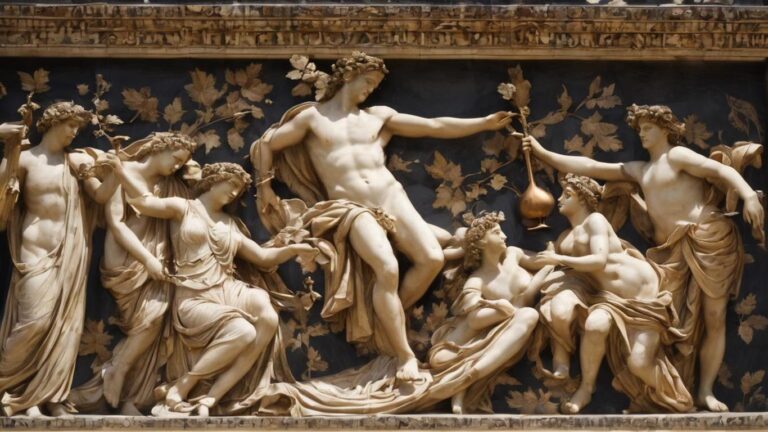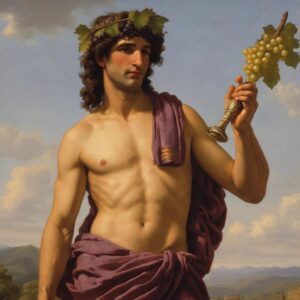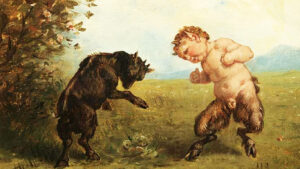Table of Contents
Who Is Bacchus?
Bacchus is the Roman name for the ancient Roman god of wine, equivalent to the Greek god Dionysus. Both Bacchus and Dionysus are associated with wine, grape cultivation, fertility, theater, and revelry. In Roman mythology, Bacchus is often depicted as a jovial and carefree figure, representing the joy and celebration associated with the consumption of wine.
Bacchus/Dionysus is an interesting figure in mythology, known for his wild and ecstatic followers, called the Bacchantes or Maenads. These devotees would engage in frenzied rituals and celebrations, often accompanied by music, dance, and the consumption of wine. The god himself is often portrayed as a liberator and bringer of ecstasy, as well as a symbol of the cyclical nature of life, death, and rebirth.
The worship of Bacchus/Dionysus was an important aspect of ancient Greek and Roman religious traditions, and the god continues to be a prominent figure in art, literature, and cultural references.
Origins
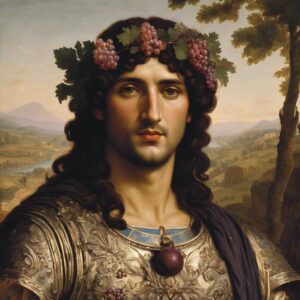
The worship of Bacchus/Dionysus has ancient roots, and the origins of this deity are intertwined with mythology and cultural development. The following provides an overview of the origins and evolution of the Bacchus/Dionysus cult:
Ancient Greece: Dionysus was a significant figure in ancient Greek mythology, associated with the vine, wine, and fertility. He was the son of Zeus, the king of the gods, and Semele, a mortal woman. Dionysus was often depicted as a young, effeminate god, and his worship involved both ecstatic celebrations and solemn rituals. The Dionysian Mysteries, a series of secret rites and ceremonies, were an important aspect of his worship.
Cultural Spread: The worship of Dionysus spread beyond Greece, reaching various parts of the ancient world. As the Roman Empire expanded and came into contact with Greek culture, the Romans adopted and adapted many aspects of Greek religion and mythology. Dionysus became known as Bacchus in the Roman pantheon.
Roman Adaptation: In Roman mythology, Bacchus retained many of the characteristics and associations of Dionysus. However, the Romans interpreted and incorporated Bacchus into their own religious practices. The Bacchanalia, Roman festivals in honor of Bacchus, were notorious for their wild and sometimes scandalous celebrations.
Symbolism and Worship: Bacchus/Dionysus was not only associated with wine and revelry but also represented the cycle of life, death, and rebirth. His worship often involved dramatic performances, including theater and music. The symbolic connection between wine and the divine, as well as the transformative nature of the god, played a crucial role in the popularity of Bacchus/Dionysus.
Cultural Legacy: The worship of Bacchus/Dionysus had a lasting impact on Western culture. The themes of ecstasy, liberation, and the celebration of life found in the Dionysian traditions influenced literature, art, and philosophy. The dichotomy between the orderly, rational Apollonian and the chaotic, ecstatic Dionysian elements became a central theme in the works of philosophers like Friedrich Nietzsche.
The origins of Bacchus/Dionysus can be traced back to ancient Greek mythology, with the worship and symbolism associated with the god evolving and spreading throughout the ancient world, especially during the Roman period. The cultural legacy of Bacchus/Dionysus continues to resonate in various forms in contemporary society.
The Birth of Bacchus
The birth of Bacchus, also known as Dionysus in Greek mythology, is a fascinating tale that involves both divine intervention and tragic circumstances. The story is as follows:
Parentage: Dionysus is the son of Zeus, the king of the gods, and Semele, a mortal woman. Semele was a princess of Thebes and a daughter of Cadmus, the founder of Thebes.
The Pregnant Semele: Hera, the queen of the gods and wife of Zeus, was known for her jealousy and often sought to punish Zeus’s mortal lovers and their offspring. Discovering that Semele was pregnant with Zeus’s child, Hera took on a disguise and befriended Semele.
Hera‘s Deception: Hera, in disguise, convinced Semele to ask Zeus to reveal himself in his true divine form, hoping that the sight of Zeus’s true glory would be too much for a mortal to bear.
Zeus’s Promise: Oblivious to Hera’s true identity and intentions, Semele made the request to Zeus. Being bound by an oath, Zeus had no choice but to comply. However, revealing his true form was so powerful that it caused Semele to be consumed by divine fire.
Rescue of the Unborn Dionysus: Zeus managed to rescue the unborn Dionysus by sewing him into his thigh. Dionysus continued to develop and gestate within Zeus until he was ready to be born.
Birth of Dionysus from Zeus’s Thigh: When the time came for Dionysus to be born, Zeus opened his thigh, and the infant god emerged. Due to this unusual birth, Dionysus is sometimes referred to as “twice-born.”
Nurturing by Nymphs: After his birth, Dionysus was entrusted to the care of nymphs, who raised and nurtured him in various locations, including Mount Nysa. Some myths also describe him being raised in secrecy from Hera’s wrath.
The birth of Dionysus/Bacchus is a complex tale involving the interplay of divine relationships, mortal vulnerabilities, and the protective actions of the king of the gods. The story underscores the challenges faced by divine offspring in the mythological world, particularly when born from the union of a god and a mortal.
Bacchus and Wine
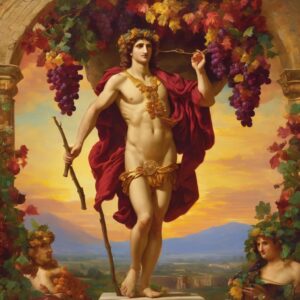
Bacchus, known as Dionysus in Greek mythology, is closely associated with wine and is often depicted as the god of the grape harvest, winemaking, and the joyous celebrations that accompany the consumption of wine. Here are key aspects of Bacchus’s connection to wine:
Invention of Wine: One of the central myths associated with Bacchus is the discovery or invention of wine. In some versions of the myth, Dionysus is credited with teaching mortals how to cultivate grapes and make wine. This gift was considered a great boon to humanity, as wine became a symbol of pleasure, fertility, and transformation.
Symbolic Representations: Bacchus is often depicted holding a thyrsus, a staff topped with a pinecone and entwined with ivy. The thyrsus is a symbol associated with the worship of Bacchus and is often used in Dionysian rituals. Grapes, vines, and wine cups are also common symbols associated with Bacchus, emphasizing his role as a god of wine and revelry.
Cultural Celebrations: The worship of Bacchus involved various festivals and celebrations, such as the Bacchanalia in Roman culture. These events were marked by music, dance, theatrical performances, and, of course, the consumption of wine. Participants in Bacchic celebrations sought to experience a sense of liberation, ecstasy, and communion with the divine.
Dionysian Mysteries: The Dionysian Mysteries were secret religious rites associated with the worship of Dionysus. Initiation into these mysteries involved rituals, symbolic acts, and the consumption of wine. The mysteries were believed to bring about a spiritual transformation and a deeper connection to the god.
Dual Nature: Bacchus/Dionysus is often depicted with a dual nature, embodying both the joyous and chaotic aspects of life. Wine, in this context, represents the dual nature of Dionysus—bringing both merriment and madness, order and chaos. The god’s associations with fertility and the cycles of nature further emphasize the transformative and regenerative qualities of wine.
Cultural Influence: The worship of Bacchus and the symbolism of wine have had a lasting impact on Western culture. Themes associated with Bacchus, such as the tension between order and chaos, the celebration of life, and the transformative power of ecstatic experiences, have been explored in literature, art, and philosophy throughout history.
Bacchus’s connection to wine is a central aspect of his mythology, and the symbolism surrounding wine in the context of Bacchic celebrations reflects the cultural significance of this beverage in ancient times.
Appearance
Bacchus, also known as Dionysus in Greek mythology, is often portrayed in various ways in art and literature. The depictions of Bacchus can vary, but there are some common elements and symbols associated with his appearance:
Youthful and Effeminate: Bacchus is often depicted as a young and effeminate god. His appearance reflects his association with fertility, life, and the youthful vigor of nature. The god is sometimes shown as a beardless youth, emphasizing his eternal, youthful vitality.
Crown of Ivy or Vine Leaves: Bacchus is frequently adorned with a crown made of ivy leaves or grapevines. These symbols represent his connection to wine, vineyards, and the grape harvest. The crown may also include clusters of grapes.
Thyrsus: Bacchus is commonly depicted holding a thyrsus, a staff topped with a pinecone and entwined with ivy or vine leaves. The thyrsus is a key attribute associated with the worship of Bacchus and is often carried by his followers during rituals and celebrations.
Drinking Cup (Kantharos) or Goblet: As the god of wine, Bacchus is sometimes shown holding a drinking cup, often a kantharos or goblet. This attribute emphasizes his role in the cultivation and enjoyment of wine.
Draped in Robes: Bacchus is typically depicted wearing flowing robes or a draped garment, reflecting his divine status. The flowing clothing adds a sense of movement and dynamism to his representations.
Companions (Maenads and Satyrs): Bacchus is often accompanied by a retinue of followers, including maenads (female devotees) and satyrs (male companions). These companions are associated with the wild and ecstatic rituals that characterize the worship of Bacchus.
Ecstatic Expression: In many depictions, Bacchus has a joyful and ecstatic expression, reflecting the celebratory and liberating aspects of his mythology. His imagery conveys a sense of revelry, pleasure, and abandonment.
Dual Nature: Bacchus is sometimes portrayed with a dual nature, embodying both the joyous and chaotic elements of life. This duality is reflected in his appearance, with some depictions capturing the god in moments of both merriment and frenzy.
Symbology
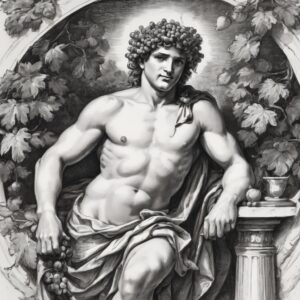
The symbology associated with Bacchus, also known as Dionysus in Greek mythology, encompasses a rich tapestry of symbols that convey various aspects of his divine attributes and the themes associated with his worship. Here are key symbols associated with Bacchus:
Grapes and Vine: Grapes and vines are among the most prominent symbols associated with Bacchus. They represent fertility, abundance, and the cultivation of wine. Bacchus is often depicted with grape clusters, and his association with the vine underscores his role as the god of wine and the grape harvest.
Thyrsus: The thyrsus is a staff topped with a pinecone and entwined with ivy or vine leaves. It is a central symbol of Bacchic rituals and is often carried by the god and his followers during celebrations. The thyrsus represents the transformative and regenerative power of Bacchic worship.
Ivy Crown: Bacchus is frequently portrayed wearing a crown made of ivy leaves. This crown symbolizes the god’s connection to wine and revelry. Ivy, with its twisting and climbing nature, also represents the untamed and wild aspects of nature.
Drinking Cup (Kantharos): Bacchus is associated with the drinking cup, especially the kantharos or goblet. This symbolizes the joyous consumption of wine and the pleasures of the Dionysian celebrations. The drinking cup underscores Bacchus’s role as the god who bestows the gift of wine upon humanity.
Theater Masks: Bacchus is sometimes associated with theatrical masks, particularly the tragic and comedic masks used in ancient Greek drama. This symbolizes his connection to theater, arts, and the transformative power of performance.
Companions (Maenads and Satyrs): The companions of Bacchus, including maenads (female devotees) and satyrs (male companions), symbolize the wild and ecstatic nature of Bacchic rituals. These followers are often depicted engaging in frenzied dances and celebrations during the worship of Bacchus.
Panther and Other Animals: Bacchus is occasionally depicted riding a panther, which is associated with his untamed and wild nature. Other animals, such as the bull, are also associated with Bacchus, symbolizing fertility, strength, and the connection between the divine and the natural world.
Dual Nature: Bacchus’s dual nature, embodying both the joyous and chaotic aspects of life, is symbolized in various ways. This duality is reflected in his imagery, which can convey both merriment and frenzy.
These symbols collectively contribute to the multifaceted nature of Bacchus as a god associated with wine, revelry, fertility, and the transformative experiences of the Dionysian rituals. The symbols also reflect the cultural and artistic interpretations of Bacchus across different civilizations and historical periods.
Who is Bacchus?
Bacchus is the Roman name for the ancient Roman god of wine, equivalent to the Greek god Dionysus. He is associated with wine, grape cultivation, fertility, theater, and revelry.
What is Bacchus the god of?
Bacchus is the god of wine, grape cultivation, fertility, ritual madness, religious ecstasy, and theater.
How to pronounce Bacchus?
The pronunciation of "Bacchus" is typically /ˈbækəs/ (BAK-us).
Who is Bacchus today?
In contemporary times, Bacchus is primarily a figure of historical and mythological interest. His influence is found in cultural references, art, and literature rather than in active worship.
Who is Bacchus in the Bible?
Bacchus is not mentioned in the Bible. The Bible does not include the worship of Bacchus/Dionysus in its narratives.
What is the role of Bacchus?
Bacchus's role is multifaceted. He is primarily associated with wine and revelry, but he also represents the cycle of life, death, and rebirth. Bacchus is a symbol of the untamed forces of nature and the ecstatic experiences associated with his worship.
What is the story of Bacchus?
The story of Bacchus involves his birth from the union of Zeus and Semele, his rescue and gestation in Zeus's thigh, and his subsequent association with wine, revelry, and ecstatic celebrations. His mythology also includes the Bacchanalia, festivals in his honor marked by wild and frenzied rituals.
Is Bacchus a real god?
Bacchus is a figure from ancient mythology and is not considered a real, living deity. However, he played a significant role in the religious beliefs and practices of ancient cultures.
Who did Bacchus love?
Bacchus's mythology includes various love affairs, but his most famous love interest is Ariadne, the princess of Crete. Bacchus rescued Ariadne and later married her.
Is Bacchus a girl? Is Bacchus a girl or boy?
Bacchus is typically depicted as a male god in mythology.
Who was Dionysus's boyfriend?
In Greek mythology, Dionysus (Bacchus in Roman mythology) is not typically associated with a specific romantic partner or boyfriend.
Did Bacchus have a wife?
Bacchus is often associated with his wife, Ariadne, whom he married after rescuing her.
How did Bacchus born?
Bacchus was born from the union of Zeus and Semele. Semele, unfortunately, perished due to the intensity of seeing Zeus in his divine form, but Bacchus was rescued and later born from Zeus's thigh.
Is Bacchus red or white?
The color association with Bacchus is more symbolic and cultural. Wine, associated with Bacchus, can be either red or white. The choice of color may vary in different artistic representations or cultural contexts.
Why was Dionysus killed?
Dionysus was not killed in the typical sense. His mother, Semele, died due to the intensity of witnessing Zeus in his divine form. However, Dionysus was rescued and later born from Zeus's thigh, ensuring his survival.
Is Bacchus a demigod?
Bacchus/Dionysus is considered a god in mythology, not a demigod. Demigods are typically the offspring of a deity and a mortal, while Bacchus is the son of Zeus (a deity) and Semele (a mortal).
